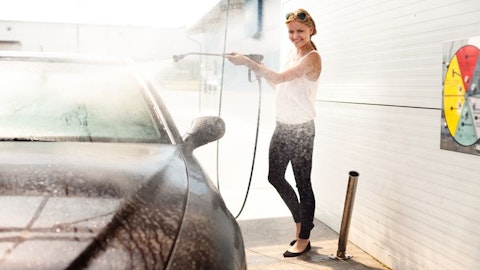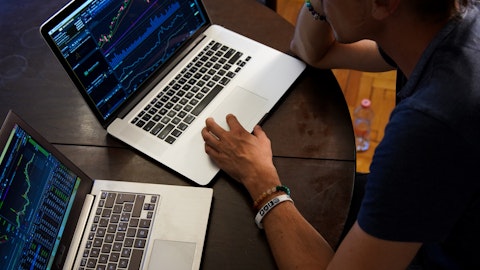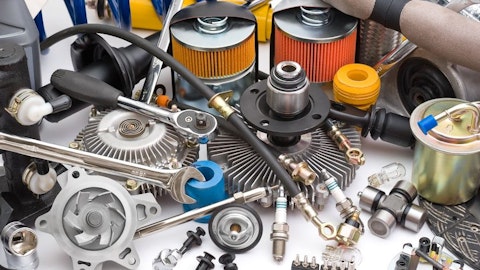XPEL, Inc. (NASDAQ:XPEL) Q4 2022 Earnings Call Transcript February 28, 2023
Operator: Greetings. Welcome to the XPEL, Inc. Fourth Quarter and Year End Conference Call. At this time, all participants are in a listen-only mode. A question-and-answer session will follow the formal presentation. Please note, this conference is being recorded. I will now turn the conference over to your host, John Nesbett of IMS Investor Relations. You may begin.
John Nesbett: Good morning. And welcome to our conference call to discuss XPEL’s financial results for fourth quarter and full year 2022. On the call today, Ryan Pape, XPEL’s President and Chief Executive Officer; and Barry Wood, XPEL’s Senior Vice President and Chief Financial Officer, will provide an overview of the business operations and review the company’s financial results. Immediately after the prepared comments, we will take questions from call participants. Take a moment to read the Safe Harbor statement. During the course of this call, we will make certain forward-looking statements regarding XPEL, Inc. and its business, which may include, but not be limited to, anticipated use of proceeds from capital transactions, expansion into new markets and execution of the company’s growth strategy.
Often, but not always, forward-looking statements can be identified by the use of words such as plan, is expected, expects, scheduled, intends, contemplates, anticipates, believes, proposes or variations, including negative variations of such words or phrases or state that certain actions, events or results may, could, would, might or will be taken or will be taken to core be achieved. Such statements are based on current expectations of management of XPEL. Forward-looking events and circumstances discussed in this call may not occur by certain specified dates or at all could differ materially as a result of known risk factors and uncertainties affecting the company, performance and acceptance of the company’s products, economic factors, competition, the equity markets generally and many other factors beyond the control of XPEL.
Although XPEL has attempted to identify important factors that could cause actual actions, events, results to differ materially from those described in forward-looking statements that made the other factors that cause actions, events, results to differ from those anticipated, estimated or intended. No forward-looking statement can be guaranteed, except as required by applicable securities laws, forward-looking statements speak only as of the date of which they are made and XPEL undertakes no obligation to publicly update or revise any forward-looking statement, whether as a result of new information, future events or otherwise. Okay. With that, I will now turn the call over to Ryan Pape. Go ahead, Ryan.
Ryan Pape: Thanks, John, and good morning, everyone. And welcome from me to our 2020 (sic) year end conference call as well. Overall, 2022 was a great year for us at XPEL. Revenue grew 25%, we accomplished our goal of exiting the year to gross margin run rate of 40%, net income grew 31% and EBITDA grew 39%. We want to always drive operating leverage as we grow and we were able to accomplish that this year. Clearly, we ran into some unexpected headwinds in Q4 in China, which I will talk about in a minute, but almost every other region had a very solid quarter led by the U.S., which continues to perform exceptionally well at 31.6% growth in the quarter. Overall, Q4 revenue grew 11.9% to $78.5 million, net income grew 34.7% and EBITDA grew 32.4%.
So good operating leverage there. And as we discussed during the last call, our forecast for China in Q4 was less than Q3 and normally, Q4 is a strong quarter for China and a slower quarter for the rest of the world sequentially. So we expected lower growth overall for Q4. The sudden reversal of COVID policies and the reopening in China, which we believe ultimately is very positive news, was clearly disruptive to the quarter. In operating the business, we require payment upfront from our distributor in China. However, our distributor extends terms in country to our dealers. So the prospect of reduced economic activity, which was sort of widely feared at the reopening, but didn’t materialize necessarily to the extent that was feared could have posed significant cash flow constraints on the distributor.
And then similarly, like us, distributors maintain higher inventory throughout COVID, going on three years, concerned both about the broader supply chain issues as we have been, but also the China specific issue of the threat of unplanned port closures that would prevent product from arriving even if it was available from us. So as a result of this uncertainty and with inventory to spare given the reopening, our distributor requested and we agreed toward the end of the year to eliminate several orders that were planned, and ultimately, it’s easier and better for us to absorb that than to ask them to take it into the circumstances. So as a result, Q4 revenue was reduced by approximately $3.5 million from our estimate in Q3. Q4 China sales came in at $6.2 million, which was a 50% decline from Q4 2021, and obviously, that’s significant considering Q4 has historically been the highest quarter for China, while it’s seasonally a lower quarter for most other regions, which normally peak in Q2 or Q3.
So all that said, I think there’s a lot to be positive about regarding the China market. Removing the uncertainty of these restrictions is good news as we see it and our distributor is equally positive in their outlook. As an example, they will now be hosting their large dealer conference this spring. Our team will be in attendance for and like ours in the U.S., these conferences are historically well attended and important and have not been held in a meaningful way since COVID started. It’s been difficult for us in conjunction with the distributor to decide when is the right time to invest further in the market up to now. We have had plans to expand our corporate team into China to better support the distributor, to get us better market intelligence, to support the car dealership in 4S groups and our OEM relationships, which are asking us about China.
But with the uncertainty over the past several years, we not move forward on those plans, but we plan to now. We have also held off on product introductions in China, like our architectural film in its entirety for similar reasons, uncertainty that prevented our distributor from hiring additional staff, from taking on additional inventory, things that you just were unwilling or was unwise to do under the circumstances, but we do plan to execute on those in 2023. So, overall, I am encouraged about our opportunities here for China in 2023 and beyond, and about our team’s ability to reengage the travel to support the operation as we have always done. I plan to visit as soon as practical and I think we can use this as a great opportunity to go much deeper on the current state of the market and make sure we are providing the distributor and all of the dealers in China what they need.
So absent the challenges in China, most of our other regions had solid quarters. As I mentioned, the U.S. market, which is our largest market, continues to be a bright spot. Revenue grew 31.6% in the quarter to $47.6 million. New car inventory continues to improve and it remains to be seen the ultimate impact of higher interest rates will be on new car sales, but new car buyers seem to still be resilient at this point most likely because of pent-up demand. And we continue to see new car dealerships trading down what is 100% margin, market price adjustment to more tangible products such as ours. And as a result, we have seen some of the highest revenue from dealership services we have ever seen in January and February of this year, which is not always the strongest months of the year.
So that’s good news. Canada, Europe, U.K. region saw continued growth for the quarter. Most of the other regions outside of the U.S. did see lower growth on a percentage basis than they did in Q3. Q3 was just red hot across the Board. So you feel that a little bit. But overall, very solid performance in really all of those other regions. Our revenue, like Q3, in Canada, U.K. and Europe continues this ongoing FX impact that we have seen all of last year due to the ongoing strength of the dollar. So on a constant currency basis, we are valuing this year or last year at prior year’s exchange rates. For the quarter, revenue and gross margin were both impacted by approximately $2 million. Latin America region had a great quarter, as mentioned on the call.
We have gone direct — much more direct in the Middle East and eliminated another layer of distribution. We are excited about the opportunity there. There was a quarter — slight quarter-over-quarter decline in the Middle East, but this is really about timing of large orders into distribution versus smaller orders direct to customers. So as we are prone to do, we know that that model tends to work better for us and so we are happy to continue to expand that there. Our last acquisition of Consequence were done in Q4 2021. So we have fully lapped those now. So effectively, even in the U.S. business, while you wouldn’t know it from 36%-plus growth, there’s a slight drag on Q4 with the dealership focus TintNet, one hand the business actually being down versus the prior year given new vehicle availability in the markets that it serves.
So that may have cost us as much as 200 basis points of revenue actually in the U.S. for Q4. So thinking about Q1, we are still seeing momentum especially in the U.S. despite this uncertain environment. Automakers still seem to be optimistic even in the face of recessionary fears and rising interest rates. In January, new vehicle sales were off to a good start, and in some respects, January and February for us be a little bit stronger than the end of the year. So, obviously, we like that trend to continue. We don’t expect much change in China revenue in Q1. Q1 is typically the slowest quarter of the year for China, because of Chinese New Year holiday and as they have expressed their desire to return to lower days on hand of inventory on a go-forward basis as we do.
So putting that together, we expect Q1 revenue to be in the $83 million to $84 million range. That’s about 17% year-over-year growth in aggregate with China down approximately 20% year-over-year and most of our other regions like the U.S., obviously growing 20%, 20% plus. One area where I was particularly pleased with our gross margin performance during the year. We have been talking this whole year and even prior about our ability to exit with Q4 with the 40% gross margin run rate. We were able to do that. We had a one-time $400,000 inventory write-off, otherwise, we would have been right at 40% for the quarter actually. A couple of other points on gross margin. We did put a price increase in some of our regions during the quarter for product, really not for services, which helped offset some of the cost increases we have seen and some of the non-build material COGS items.
And when our China volume is low, historically, it’s been more accretive to gross margin percentage, because China is a lower margin market for us with distribution. But as China has become a smaller percentage of sales and as the U.S. has continued to have grown, that effect is certainly much less pronounced today and you don’t really see it. And we have, over the short term, fixed costs embedded in gross margin like production labor, the cost of designing patterns for the VAP, equipment depreciation, et cetera, that have to be earned through, especially when you have an abnormally low revenue quarter like Q4. So implicit in that kind of 40% exit run rate is actually some negative impact to gross margin, otherwise, we would have been even slightly higher in a more normal quarter.
So good, great progress. Good work by the team. We are very pleased with that. So Q4 gross margin grew 25.7% to $31 million. It translated, as I said, the gross margin percentage 39.6% and plus that $400,000 right at 40%. I will also note that our Q4 2021 gross margin percentage was 35.2%, so tremendous improvement in 2022 and our 2022 full year gross margin percentage finished at 39.4% versus 2021 at 35.7%. So, obviously, a tremendous improvement there. And we still have runway to improve this, really driving from all the things that we have discussed, the focus on cost product mix, channel mix, et cetera. It’s an open question based on where we see the most growth of how high it can go in coming years, but another 200-basis-point improvement by the end of 2023 is certainly not beyond the realm of possibility and what we are actually expecting to exit the year on.
We see higher SG&A as a percent of revenue this quarter and lower revenue certainly contributes to that as we have built-in fixed costs, obviously. We did incur approximately $300,000 in severance costs and we also incurred $400,000 in compensation costs related to the previous acquisition. Technically, it was not eligible to be paid on the earn-out as the targets were not achieved under the terms of the original purchase agreement for various reasons. However, we accomplished a lot of other things sort of tangential to the acquisition. So in the spirit of the deal, we thought it was the right thing to do for the business. So we have incurred that expense. We have traded some gross margin for SG&A costs, but we know we can earn through the SG&A over time and in the higher revenue quarters.
As an example of how this works, when we do acquisitions such as our distributor we acquired in Australia, shipping expense to Australia that was previously a wash in cost of goods, because the former distributor paid it, is now fully present in SG&A as it’s an internal transfer shipment. So you see that grow as SG&A, but actually offset in the form of improved gross margin. So all of these things that we do, there’s a slight collateral effect where to a small degree we trade gross margin — increased gross margin for higher SG&A expense, but the net effect is still that we can grow the leverage of the business. Now Q4 EBITDA grew 32.4% to $13.2 million, reflecting an EBITDA margin of 16.8%. So good leverage in the quarter even with all the other things we mentioned that impacted us.
Our year-end inventory finished approximately $80 million. This was actually up about $11 million from Q3. Our reduced China volume obviously contributed to that, but there is still momentum in our inventory purchasing, and much as I have pushed the team to reduce the stays on hand faster. We have honored many handshake commitments to our vendors who have accelerated their production for us when we were more concerned about supply chain and total inventory dollars over the past few years. So we have been fortunate to have had the support of these vendors to prioritize our business, sometimes at the expense of others over the past three years, down from every component of the product down to the corrugated suppliers, which resulted in us effectively never being out of stock on anything, which is something our competitors couldn’t necessarily claim.
So as we reduce the days of inventory on hand, it’s imperative that we maintain the relationships that have helped get us there. So the team has slowed me down a little bit on that, which just means this just takes a bit longer to work through, but it’s the right move. And given the revenue growth we expect this year, inventory probably doesn’t go lower than $75 million, but it still means we do not expect to commit substantial cash flow to inventory this year like we did in 2021 or 2022 and we are planning across all product categories or reduce days on hand. So over the course of the year, this should more than offset the increase normally required to support the growth in revenue, albeit on a slightly slower schedule than we had initially hoped.
We have had really good success with the acquisition of our Australian business. Revenue is now trending at more than double from the prior year period when looking month over prior year month. We have also reduced selling prices in the country by double digits on our paint protection films to better align with the market price and drive growth over unit economics, which sometimes distributors can prioritize. So it’s a great example of where our direct approach pays dividends, and again, we are looking at a market like Australia, which is a fraction of the revenue of Canada, but only 10 million fewer people. So I think we see why this will be successful. So with that, we are looking at several other countries with similar dynamics to enter for 2023 with a similar strategy in mind.
We intend to complete a number of acquisitions in 2023, similar to those we have done before, especially as reducing our days on hand of inventory and stop committing our cash flow to working capital at the same rate we have. We released a new version of our DAP platform, DAPNet. This is in beta to all of our customers now. As we talked about previously, this is a rewrite of our core DAP system that will support more of the business operations of our customers with the goal of making them more efficient and providing incrementally that much more value to them. So updates roll out weekly and will continue going forward. Much of the work as part of this data release is around updating core functionality and then move on to more of the new features as we go forward, but team has done a great job and a lot of effort put into this and a lot more to come.
We have done some things in the fourth quarter that are painful today, as I discussed, but they are the right thing for the business long-term and we wouldn’t have it any other way. Overall, I think, there’s a lot pretty positive about this coming year even in light of sort of the macro uncertainty. As I said, all of our regions continue to display momentum, especially the U.S. There’s positive news coming out of China as we get through Q1 and we should start to see a lot of good things happening, particularly product expansion plans there. Our architectural window film business continues to grow. We have a long runway in that product segment, OEM business, which is about 3% of revenue today had a good year setting up for a great 2023 and we have a variety of expansion opportunities within the current book of business and the new projects that are contemplated.
Much of our view into the future is extrapolating trends we see in the present, which is limited to our forecasting. But at this point, we are looking at 20% to 25% organic revenue growth for the year. As I mentioned earlier, we fully lapped our significant acquisition. So there’s no inorganic component to our growth at this point without considering future acquisitions that we may do this year. Of course, anything can change, we have had a good start to the year. As I mentioned earlier, we expect gross margin to improve around 200 basis points throughout the year to get us to that sort of ending run rate again, a 200-basis-point improvement and we expect SG&A in the 22% range, that’s plus or minus 1% probably. This should give us significant leverage and drive earnings growth for the year, while allowing us to invest in the business substantially.
We are increasing our marketing spend on a percent of revenue basis, but we can do that within that range and still generate significant leverage for 2023. So, overall, fourth quarter notwithstanding, I am very pleased with our performance this year. The team has worked incredibly hard. You can imagine the number of moving pieces with everything we are doing and I really thank them and we are excited about this coming year. So, with that, I will turn it over to Barry and then we will take some questions. Barry, go ahead.
Barry Wood: Thanks, Ryan, and good morning, everyone. I just want to cover off a couple more items on our topline performance. If you look at the product lines, paint protection film was flat during the quarter. But as we have discussed in the past, cutbank revenue is just to require accounting reclassification. So it makes sense when you look at PPF to combine cutbank revenue with our PPF line and our external reporting to get a full picture of PPF. Combined, paint protection film and cutbank revenue grew a little over 4% in the quarter. So the significant China decline quarter-over-quarter had a good size impact here. Our window film product line continued to perform well with revenue growing 33.7% quarter-over-quarter at $11.7 million.
This is down sequentially from Q3, which is expected as this product line does have some fairly consistent seasonality with Q2 and Q3 being the highest quarters. On a year-to-date basis, our window film product line grew 41.7%. Our Q4 vision product line, which is our architectural window film, revenue grew 95% to $1.2 million, and on a year-to-date basis, vision revenue grew 98% to $5.7 million. And also, as Ryan mentioned, our OEM business had a great year with revenue growing approximately 64% to $10.2 million. Our installation — our total installation revenue, combined product and service, grew 27% in the quarter and represented 17.4% total revenue. On a year-to-date basis, total installation revenue grew 77% and represented 15.7% of revenue.
Same-store sales growth for the quarter was 18% and 40% on a year-to-date basis. Our Q4 SG&A expense grew 25% to $20.2 million and represented 25.7% of revenue, as we talked about before. And I would echo Ryan’s comments on SG&A that there is no doubt that we have certain fixed costs built into our SG&A infrastructure that when we have a down revenue quarter like Q4 we certainly feel it. Despite that, and Ryan mentioned this also, we still saw some nice operating leverage in the quarter and remain very confident that our expense cadence will continue to provide great future returns. Our Q4 EBITDA grew 32.4% to $13.2 million, reflecting EBITDA margin of 16.8%. And if you assume China would have been expected run rate and normalizing for the items Ryan mentioned, EBITDA margin would have been approximately 18%, and on a year-to-date basis, EBITDA grew 38.7% and our EBITDA margin was 18.9%.
Our Q4 net income grew 34.7% to $18 — $8.4 million, reflecting net income margin of 10.6%, and our EPS was $0.30 per share. If you factor in China and normalize for the other items, net income margin would have been approximately 12.1% when EPS would have been $0.36 per share. Cash flow from ops for the quarter was $2.4 million, which was a good result in light of the inventory increase we saw in the quarter and we expect to continue to generate strong cash flow in the long-term, but near-term cash flow could moderate as inventory in the channel continues to level out. But regardless of all that and really solid performance for the year, we are set up to have a great performance in 2023. And with that, Operator, we will turn the call over for questions.
See also Diversified Stock Portfolio: Sector ETFs to Buy and 25 Most Expensive Countries in Europe .
Q&A Session
Follow Xpel Inc. (NASDAQ:XPEL)
Follow Xpel Inc. (NASDAQ:XPEL)
Operator: Thank you. The first question is coming from Steve Dyer with Craig-Hallum. Steve, please proceed.
Steve Dyer: Thanks. Good morning, guys. A lot of good detail in the prepared remarks, which is as always appreciated. Within the auto space, in general, it sounds like a dealer business continues to do really, really well. I guess could you help us sort of see or what you are seeing there in terms of adding dealers or are they just sort of buying in more to kind of the profitability opportunities in selling this stuff? Are you seeing greater attach rates, are you seeing greater number of pre-loaded vehicles versus not, any color there would be great?
Ryan Pape: Sure. Steve, yeah, I think, it’s a little bit of all of the above. The dealership business, especially the end of the year into the beginning of this year has really been a bright spot for us, and by a lot of the metrics, we are seeing some of the best performance that we have. And so some of that is related to just the return of inventory where we have revenue in some parts of the business. Preload, as you mentioned, it’s more coupled to inventory, so we stand to benefit from that. But we are adding for — all of the various product lines we are adding a large number of dealers, and we have seen very good momentum with this. And it’s not the exclusive reason, but one of the reasons we have heard more than once is that as you are in this environment where the market adjustments are under pressure and have to go away, because the inventory is back, that’s cut out this 100% gross margin opportunity for these dealers and they need to trade that down to still generate the gross margin dollars, but to give the customer something for it instead of just that.
So that’s — we are definitely seeing that in quite a few of those cases. And then we have also had success and really, this has been true since we did the acquisition of PermaPlate in 2021 of adding more products and more content per vehicle too within the current relationships that we have and that could be introducing paint protection film at some level that there was only a window film before. It could be upsell to higher line of window film. It could be door cups and door edge guard protection and things like that, that might be preloaded. So it is a bright spot and it’s really all of the above, all the things that you mentioned.
Steve Dyer: Got it. Thank you. It sounds like acquisitions are sort of back more front burner this year. Can you sort of help lay out directions or generalities as to what we should expect?
Ryan Pape: Yeah. No. We — I think we have got a pretty good carryover from last year on things we were working on that just couldn’t come to fruition for one reason or another. But the things we are going to see really at the top of the list are international distribution. We used the example on the call today of Australia and how we see in a case at almost no fault of anyone, but where the third-party distribution, you can run out of alignment with the goals of the distributor versus our goals and our goal is not to maximize every unit of profit in a market that some independent business might be. So definitely more international activity for other key markets we might want to enter. That would be one. Dealership services and everything that you just asked about, Steve, there are other smaller companies doing some of these things like what PermaPlate did and we think it makes sense to add to that business, we get some economies of scale by doing so.






